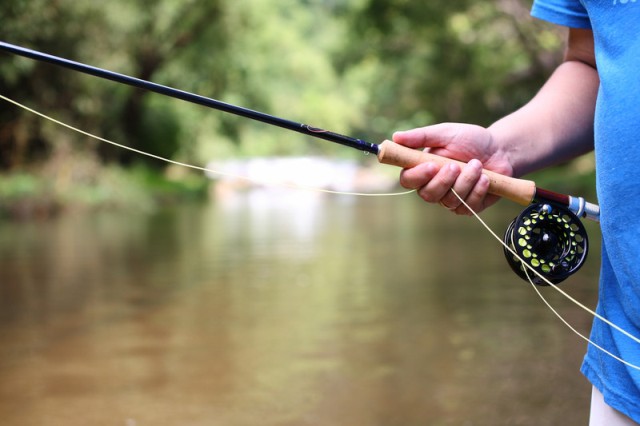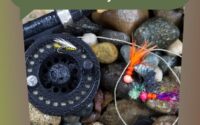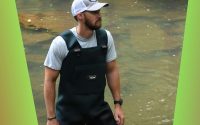| Disclosure: Just to be open and honest the buttons and links you click on in the website will in most cases take you to another website where you can purchase the products I am reviewing. As an Amazon Associate I earn from qualifying purchases. |
How to Trout Fish with a Fly Rod – Part two, the rod.
So in the last post we talked in general about trout fly fishing and what equipment is required to start off as a beginner.
Now we shall go into more depth in each area so you can better understand the sport.
In this post we shall discuss the differences in the makes and models of trout fly rods.

First off each fly rod is stamped with a line rating on its butt section.
This line rating is designed to allow you to match up the correct fly line and reel so the setup is balanced and suitable for casting properly.
The AFTM Association of Fishing Tackle Manufacturers came up with the system many years ago to help manufacturers make products to match so retailers and anglers could be easier provided for.
Quick Post Navigation
What size of trout fly rod to use?
The main principle behind line rating from 0-16 gets heavier as you go up in size.
It will take a stronger and usually longer rod to cast properly.
In general, a 4 or 5-weight line rating would be for an 8ft rod catching trout up to 2 lbs.
A 5-6 would be 9ft trout up to 4-5 lbs
A 6-7 would be 10ft for trout up to 10-15 lbs.
These are not exact figures but general approximations.
The larger line ratings are for salmon, pike and larger species and not really used for trout unless you are going after 20-25lb trout in which case an 8-9 weight rod may be required.
So when you have decided what size of trout you will be targeting you can decide on the line rating that suits you best.
As a beginner, I would opt for something between 9 ft #5 weight or 10 ft #6 line rating this gives you the best starting point and covers a lot of situations.
You can always add to your collection as you get more experienced and as time goes by.
Any fly fishing angler I know has a large collection of fly rods and in some cases it becomes an obsession.
I myself have about a dozen rods ranging from an 8ft #5 weight to 15ft #10 weight salmon rod with options in between.
There are so many manufacturers making good quality fly rods that is always nice to have options to try on a days fly fishing for trout.
Lights, camera, action! Not that kind of action.
OK so we have opted for a 9ft #5 weight fly rod, the next thing to consider is the action.
The action of a fly rod is measured in flexibility the softer the rod is, the easier it is to cast as the timing is longer between forward and back casts.
The faster a rod is the quicker you need to be to get the cast performed.
In so doing this keeps the loop formed by the fly line tighter which leads to further casts.
This is the reason more anglers are going for faster-actioned rods to get the distance in the cast.
Fly fishing is not all about distance!
This is a miss conception, you do not need to be a master at distance to catch trout on the fly.
If anything obsession with distances can hinder a fly angler in the art of actually learning how to fly fish.
When more concerned with distance they are missing the water between them and the fly.
That being said there will be times when a trout is showing just beyond your reach that teases you time and time again by breaching.
My response is forget about it and target one closer and just enjoy the show.
Do not fall into the trap of distance casting.
For example, I went on a fishing trip to Russia a few years ago with a group of twelve anglers.
We were all geared up with 12ft plus double-handed fly rods and large shooting head lines all designed to get the fly out far.
All OK so far however there was one angler with us who had never salmon fished before but was an accomplished trout fly fisherman.
While we were all trying to cast out flies to the far banking this guy was only making it halfway.
Nevertheless, he managed to catch more fish for the week than the rest of us.
My point you do not need to be a big caster to cast salmon or trout.
You will catch more fish casting within your limits and fishing the flies correctly.
Those are the two main things to consider when purchasing a new fly fishing trout rod although they are not the only things.
Another important point would be the number of sections the rod comes in.
Frequent flyer are you?
Ideally, a fly rod would come as one piece as then there would be no compromises in action through the connections.
However, this is impracticable as putting a 11ft rod into a small car is going to be a problem.
As more and more anglers travel to fishing destinations by airplane the need to pack a rod into a small space is needed.
This is where the frequent flyer rod series has come into existence.
Rods for traveling are usually 4-7 pieces in length and fill the need fairly well however, the extra connections in the rod length do cause small lapses in action and can make them more difficult to cast than a 2-3 piece fly rod.
This fly rod is one to add to your collection for those dream destinations but not necessary for fishing local rivers and lakes.
Other differences in trout fly rods are color, ring type, butt type and reel seat.
For color, these can vary from very light to dark and matt to a high gloss.
This is very much a personal choice but I would stay away from high gloss and bright colours.
Trout can be very wary in certain lakes and fisheries and a flashing bright rod will cause them to move away from you.
I would recommend a neutral color that is matt or soft sheen then you should avoid this happening.
Snakes go fly fishing too!
Rod rings come in many types from snake rings to single-leg and double-leg attachments.
Of these snake and double rings are the strongest but add to the weight of the rod although this would be minimal.
These also come in many metals and the strongest lightest material costing the most.
For our beginner rod, I would opt for snake rings which are cheap but amply strong for learning.
The fly fishing rod handle has a few options.
From full and half wells to fighting butts and extensions.
This is not that important for our first rod but something you can add to your collection.
However the addition of a fighting butt which can be screwed on or of can add an extra function for fighting larger trout.
In essence, it extends the rod at the butt so you can put your second hand on it to help land a prize trout.
Not really necessary for small trout.
The reel seat can also be a personal choice as the connecting of a reel to the rod is fairly similar except for some manufacturers putting in images of fish or engravings which add to the look of the rod but not much to the function.
So to sum up if fishing for trout in the 2-10lb range I would opt for a 5-6 weight 9-10ft, 2-3 piece rod which is neutral matt in colour with a full wells handle and snake rings.
This should offer you a good functional rod that will cover many situations.
Then as you grow in the sport you can add additional rods of different lengths and weights to cover more situations as your budget allows.
Part 1, Part 3, Part 4 , Part 5



You wrote quite a bit about distance – do a lot of people try to cast out as far as possible?
Hey Nathaniell fly fishing anglers are always testing out their skills with their fly rod and there are a few ways to do that, distance and accuracy to name two. In fact I would recommend to newbies to practice these weekly to get the best from their fly fishing. However when actually fishing stealth is more important.
If you can cast a fly to a trout sitting under a tree on the far banking about 30 yards away with pin point precision then you are an accomplished angler. These are not skills that come easy and take a lot of skill to perform properly. However when done correctly they can increase your bag catch size dramatically. One thing I do find is fly fishing anglers trying to do these precision casts when they are not skilled to do so and end up creating a disturbance which spooks the trout they were targeting away out of sight. Another wasted opportunity!
I would always start out with short casts around my area taking a cast on each number on the clock face as it were so you are hopefully covering all the trout that are first off close to you before trying to extend the cast further out. You may find all the action is close to you and there is no need to cast any distance at all. This is particularly true when fishing is a lake on a boat. If fishing quietly there is no need to cast long distances at all as the trout come to you. 🙂
Very informative article. Great guidance on what to get to get started.
I had no idea there was so much to consider to get the right rod.
Thanks Colm, there is quite a bit of info there, 🙂 Most modern fly rods are now so well made that they are balanced and ready to fish with out of the tube. However with a bit of extra thought you can see the good from the bad and end up with a fly rod that will fish better and hopefully catch you more trout.
Thanks Mark. It’s pretty impressive what’s available today.
Tell me, I’m starting out and so more or less completely new to fishing. As well as your recommendations in the article above, can you advise how much I should spend on a starter rod? A general range as such.
Are there one or two starter rods you recommend?
There are so many options it’s hard to know where to start and I think, like anything, you could probably overspend quite easily. While i’m sure the quality would be great for a higher price, it would probably be a bit of a waste on a newbie.
Hey Colm yea you are correct you can get into serious money very quickly if not careful. There are so many makes and models and the price goes up as the quality goes up.
It does really depends on your budget and what you can spend without feeling pressured. The thing about fly fishing gear is if you don’t take to it you can always sell on the gear at a reduction. In fact if you turn up at your local tackle dealer you my find he has some second hand stuff for you to try out. If you do like the sport you can always upgrade later on.
As I pointed out if you are a true fly fishing angler you will end up with a collection of rods over time. However if you are looking for a cheap starter kit that has decent quality then this Airflo Kit is well worth a look. 🙂 Tight lines and feel free to discuss any issues with me before you buy.
Thanks Mark, I appreciate the information and advice.
I’ll check the Airflo Kit out, thanks for the link. No doubt I’ll be back with more questions 🙂
Thanks again!
No problem thanks for stopping by. Tight lines and I hope to hear about your fly fishing trips in the future. 🙂